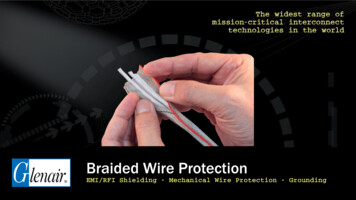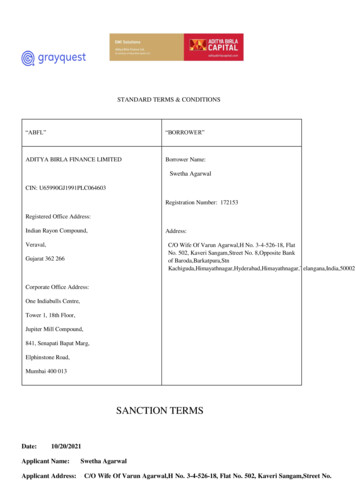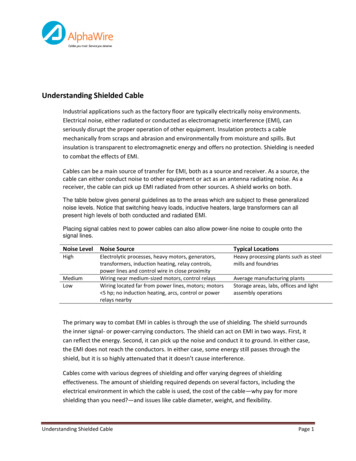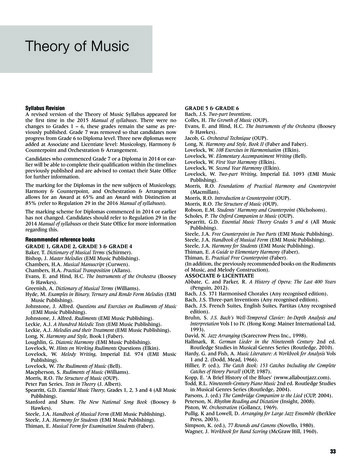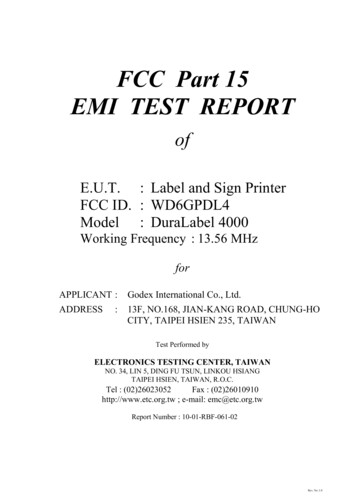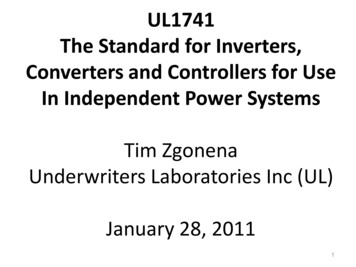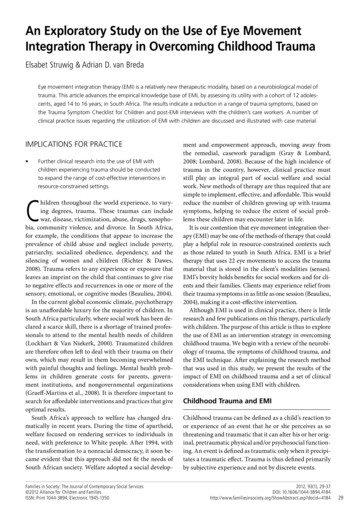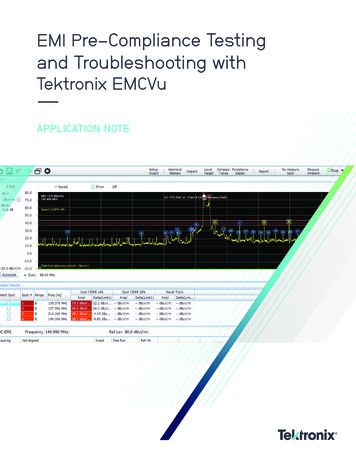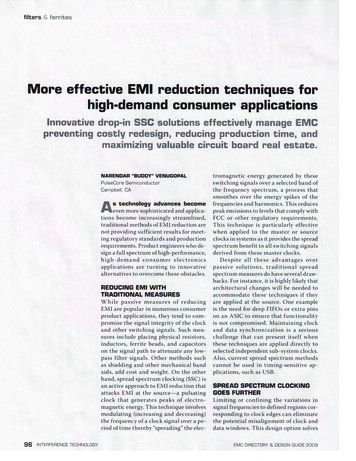
Transcription
filters & ferritesMore effective EMI reduction techniques forhigh-demand consumer applicationsInnovative drop-in SSC solutions effectively manage EMCpreventing costly redesign, reducing production time, andvaluableboard realNARENDAR "BUDDY"VENUGOPALPulseCore SemiconductorCampbell, CAAs technology advances becomeeven more sophisticated and applications become increasingly streamlined,traditional methods of EMI reduction arenot providing sufficient results for meeting regulatory standards and productionrequirements. Product engineers who design a full spectrum of high-performance,high-demand consumer electronicsapplications are turning to innovativealternatives to overcome these obstacles.REDUCING EMI WITHTRADITIONAL MEASURESWhile passive measures of reducingEMI are popular in numerous consumerproduct applications, they tend to compromise the signal integrity of the clockand other switching signals. Such measures include placing physical resistors,inductors, ferrite beads, and capacitorson the signal path to attenuate any lowpass filter signals. Other methods suchas shielding and other mechanical bandaids, add cost and weight. On the otherhand, spread spectrum clocking (SSC) isan active approach to EMI reduction thatattacks EMI at the source—a pulsatingclock that generates peaks of electromagnetic energy. This technique involvesmodulating (increasing and decreasing)the frequency of a clock signal over a period of time thereby "spreading" the elec96INTERFERENCE TECHNOLOGYtromagnetic energy generated by theseswitching signals over a selected band ofthe frequency spectrum, a process thatsmoothes over the energy spikes of thefrequencies and harmonics. This reducespeak emissions to levels that comply withFCC or other regulatory requirements.This technique is particularly effectivewhen applied to the master or sourceclocks in systems as it provides the spreadspectrum benefit to all switching signalsderived from these master clocks.Despite all these advantages overpassive solutions, traditional spreadspectrum measures do have several drawbacks. For instance, it is highly likely thatarchitectural changes will be needed toaccommodate these techniques if theyare applied at the source. One exampleis the need for deep FIFOs or extra pinson an ASIC to ensure that functionalityis not compromised. Maintaining clockand data synchronization is a seriouschallenge that can present itself whenthese techniques are applied directly toselected independent sub-system clocks.Also, current spread spectrum methodscannot be used in timing-sensitive applications, such as USB.SPREAD SPECTRUM CLOCKINGGOES FURTHERLimiting or confining the variations insignal frequencies to defined regions corresponding to clock edges can eliminatethe potential misalignment of clock anddata windows. This design option solvesEMC DIRECTORY S. DESIGN GUIDE 2009
Losing sleep over EMI?Symptoms include.Unreasonable trade offs between performanceand emissions.Product delays caused by inability to pass FCCapproval.Excessive use of passives and other acts of desperationRest easy with PulseCore Timing-Safe,TMthe industry’s only true drop-in spreadspectrum EMI reduction IC.Conventional spread spectrum techniques can have severe sideeffects, like performance trade-offs, architectural compromises, andthe engineer’s worst nightmare — loss of clock/data synchronization.Solve unexpected EMI emergencies with fast-acting Timing-Safe,TMthe industry’s only true drop-in EMI solution that provides spreadspectrum on any clock path. For more information or to obtain asample, visit www.pulsecoresemi.com.DATACLOCKAfter Timing-SafeTMAmplitude of the spectral harmonics isreduced significantly.Don’t lose sleep over EMI. Think Timing-Safe.TM Think PulseCore.WARNING: If you have too much time on your hands or too much money in your budget,you should not use Timing-Safe.TM Side effects may include accelerated performance,rapid time-to-market and severe cost savings.PulseC reGiving you the edge
MORE EFFECTIVE EMI R E D U C T I O N TECHNIQUESHow isfinding the right corefor your EMC designmaking you feel today?SS Disabled wowed .to be able to reach your customerservice team with product questionsLocked andSynchronizedFigure 1. Consider the waveform illustrated in two spread spectrumdevices, in which A is a standard spread spectrum device and B is adevice that employs true drop-in spread spectrum technology. Whendisabled, both devices lock synchronously to the input signal.by the level of in-stock inventory inprototype-to-production quantitiesInputSS EnabledUnlocked andUn-synchronizecFigure 2. Now, consider the same two devices with spread spectrumenabled. The output waveform of device A, the conventional spreadspectrum device, is completely out of synchronization with the input.to find most products can bedelivered to you in 24 hoursOn the other hand, the waveform of device B, which employs a newtechnology, is synchronized, in phase, and exhibits an extremely wellcontrolled spread spectrum modulation.If you aren't feeling this way,then look to Dexter.In North America: 800-775-3829In Europe: 44-1189-602430In China 86-512-62620226info@dextermag.comDEFTERMagnetic TechnologiesEMI Suppression CoresBobbins i ThermistorsSpecialty Serviceswww.dextermag.com/IT.aspx98INTERFERENCE TECHNOLOGYa major drawback of traditional spread spectrum EMIreduction, and there are innovative technologies thateffectively reduce the peak amplitudes of clock signalswhile maintaining synchronization throughout thesystem and protecting data integrity—thus, eliminatingthe possibility of cycle slip, which is detailed above. Atthe same time, Federal Communications Commission(FCC) compliance can be achieved using this type oftechnology.ELIMINATING CYCLE SLIPWhile faster data rates have made FCC complianceEMC DIRECTORY & DESIGN GUIDE 2009
filters & ferritesVENUGOPALa challenge, spreading the mas- clock path—providing true drop- spread spectrum EMI reductionter clock at its origin is the first in solutions to reduce subsystem technology. With high-definitionchoice in meeting FCC standards EMI on any clock path. These EMI video increasingly in demand, LCDand offers an ideal approach. This reduction ICs are flexible and can TV sales are on the rise. Sales aremethod keeps the data and the be added at any point in the design expected to skyrocket in the Unitedclock synchronized throughout the process—early or late—to achieve States when all broadcast televisionsystem. Often, the master clock gets FCC compliance with minimal stations end analog signals and begindistributed to multiple subsystems. redesign. See Figures 1 and 2 for a broadcasting only in digital in JuneSeveral subsystems could function comparison of results from a device 2009. LCD TV manufacturers arewell with spread spectrum applied that employs conventional spread preparing to take advantage of thisto the master clock. In certain de- spectrum clocking and a second opportunity by offering bigger andsigns, however, subsystem clocks device that employs true drop-in better LCD TVs. Unfortunately, anincrease in size and performancemay require independent spreading spread spectrum technology.also produces moreof EMI. In such cases,EMI. If EMI levels dothe data and the clocknot meet FCC requirecan lose synchronizaDespite all thesements and a systemtion and can produceover passive solutions, traditional redesign is required ata cycle slip.the end of a product'sStill, there arespread spectrum measures dodesign cycle, producICs that can providehave several drawbacks.tion time and costsspread spectrum clock could increase signifimodulation for EMI cantly.reduction without theWhen one leading LCD TV manuassociated cycle slip. These devices LOWERING PEAK EMI LEVELSfacturer's product was nearing theemploy a unique proprietary, patent- IN AIM LCD TV APPLICATIONpending technology, and they can be LCD TVs are one example of an ap- end of its production cycle and didinserted directly into the subsystem plication that benefits from drop-in not achieve FCC compliance, thefFair-Rite Products Corp,Your Signal Solution 9jfSearchfV.„,.'Engineering Solution, Economic Solution, gYour Signal Solutiont«P Fair-Rite Products offers a wide range of ferrite materials to meet your design requirements as well as maintainyour budget. Work with our experienced team of Applications Engineers to select the appropriate material for yourfrequency range. Core size and weight will also be considered to provide the most cost-effective solution.For technical support, click on the "Ask theAdvisor" feature of our website or call amember of our Applications Engineeringteam.\Engineering Solutions with Economic Value - A decision you can afford to make.Fair-Rite Products Corp.Your Signal Solution interferencetechnology.comPO Box J, One Commercial Row, Wallkill, NY 12589-0288 USAPhone 888-324-7748 / 845-895-2055 / Fax 888-337-7483ferrites@fair-rite.com / www.fair-rite.comINTERFERENCE TECHNOLOGY99
filters S ferritesMORE EFFECTIVE EMI REDUCTION TECHNIQUESmanufacturer needed an expedientsolution. Designers needed to addressthe problem of EMI originating froma 61-MHz low-voltage differentialsignaling (LVDS) clock. Previously,magnetic-shielding rings had beenused to reduce the EMI at the LVDScable. Increasing the number of ringswas considered as a possible solution,but this would have increased production time and costs—and even thesize of the cable itself. At that point inthe production cycle, this was time,money, and space the manufacturercouldn't afford to lose.Applying the drop-in 1C at theLVDS clock dramatically loweredpeak EMI levels during subsequentcompliance testing. This new technology enabled the manufacturer tomeet FCC standards without addingmore magnetic-shielding material.The manufacturer was even able toreduce the use of this material by 75percent, a change that saved valuableprinted circuit board real estate andadditional production costs.CONCLUSIONDrop-in spread spectrum technology has dramatically changed theway product engineers can applyspread spectrum modulation techniques to a variety of platformsand applications. By ensuring thattiming-sensitive interfaces andIP blocks within systems are notimpacted by the altered clock, thisflexible and compact technologycan be used easily and effectivelyin systems that were once ill-suitedto SSC because of likely performance degradation and functionalfailures. This technology is wellsuited to several applications andinterfaces, such as USB, HDMI, andLVDS, among others. Designers cannow confidently push the limits ofsystem performance while comfortably meeting the growing demandsfor cutting-edge consumer applications using this true drop-insolution.NARENDAR "BUDDY" VENUGOPAL is aFounder, Chief Technology Officer and VicePresident/General Manager of PulseCoreSemiconductor. Buddy has 20 years of mixedsignal 1C design, operations, marketing, andmanagement experience. He holds graduatedegrees in electrical engineering and appliedphysics from the Indian Institute of Sciencein Bangalore, India, and the University ofCalifornia, San Diego and undergraduatedegrees in physics and electronics.PulseCore Semiconductor is a leadingprovider of standard and custom high-speed,low-power analog and mixed-signal siliconsolutions for EMI reduction, clocking, powermanagement, and system monitoring. MORE ON OUR WEBSITEI Spread spectrum clocking is anincreasingly popular techniquefor forestalling interference.Design concerns involving this andother techniques are discussed inpapers found in articles archivedon lnterferenceTechnology.com d an EMI Filter?Visit Us Online!Dont throw money down the drainbuyng from pricey distributors!.Quality. Expertise. Solutions.CORPORATION5040 . County Rd.Jipp City, Ohio 45371 Phone:(937)667-8484 Fax:(937)667-5133www.captorcorp.com 2007 Captor Corporation100INTERFERENCE TECHNOLOGYElVI Fitter Company sells direct/No minimums/No middlemen/No hassles/Low-pass EI71I / RR fitters in boft. solder-in,and our patented Talon Grip press-in bodiesEMI FILTER COMPANY1-8OO-323-799Owww. emifiltercompany. comEMC DIRECTORY S. DESIGN GUIDE 2009
hand, spread spectrum clocking (SSC) is an active approach to EMI reduction that attacks EMI at the source—a pulsating clock that generates peaks of electro-magnetic energy. This technique involves modulating (increasing and decreasing) the frequency of a clock signal over a pe-riod of time thereby "spreading" the elec-
